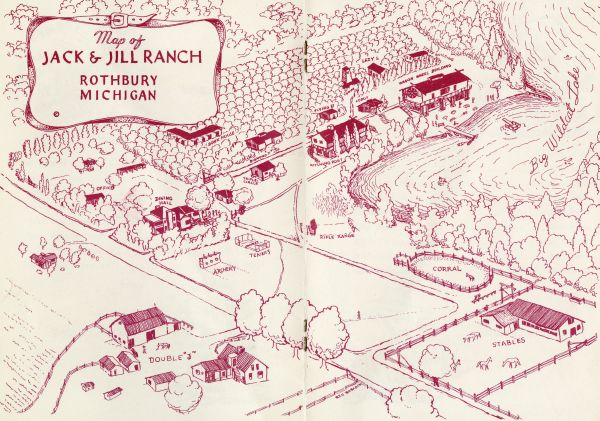These Wheaton College girls, possibly gathered in a Williston Hall dormer, pause during a Christmas celebration to pose for this photo from the early 1900s. A sketch of Abraham Lincoln, wearing Roman robes, glowers down on the somewhat somber party, though the young lady sitting front and center seems a bit more relaxed, if not downright mischievous. The woman in the striped skirt appears to be wearing an elf cap, or perhaps some form of traditional seasonal headdress.
All posts by Keith Call
Jack & Jill Ranch on Big Wildcat Lake
Before Camp Honey Rock (later Honey Rock Camp) became firmly established as a favorite getaway destination, Wheaton College faculty and students seeking a fresh blast of the great outdoors slipped northward to the Jack & Jill Ranch (“for young people, 19-35 years old”) in Rothbury, Michigan, about 200 miles from campus. The 650-acre lakeside property provided an ideal venue for horseback riding, swimming, boating, canoeing, archery, riflery, meals and lodging.
In addition to these activities, the promotional booklet loudly boasts, “Dance music is provided by our own orchestra. There’s square dancin’, too…we’ll teach you right from scratch.” Abiding by the Wheaton College rules of conduct, students probably quite reluctantly refrained from “dancin'”, especially in the presence of college administration. And when Sunday rolled around, guests were transported to one of “…our little Catholic or Protestant churches in the quaint village of Rothbury.”
In May, 1953, the Senior Sneak, comprising the entire graduating class, fled campus and settled for two days at the Jack & Jill Ranch. 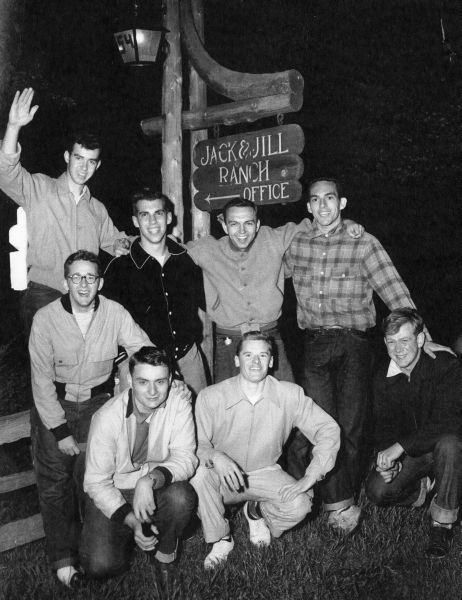 In addition to hearty relaxation, the Senior Sneak organized a worship service with Dr. V. Raymond Edman, President of Wheaton College, conducting the communion table. The Sneak, probably gathered around a roaring campfire, sang their class song:
In addition to hearty relaxation, the Senior Sneak organized a worship service with Dr. V. Raymond Edman, President of Wheaton College, conducting the communion table. The Sneak, probably gathered around a roaring campfire, sang their class song:
We’re on the road to victory,
And we can fight as you will see,
As we throng around,
You’ll hear the sound
Of cheering loud and free, Rah! Rah!
We are the first in all the fun,
Loyal we stand through gloom and sun;
Pressing forward together
In any kind of weather,
We’re the class of ’53.
Today the former Jack & Jill Ranch is the 1000-acre Double JJ Resort, including a golf course, water park and conference center. The Double JJ occasionally hosts the Rothbury Festival, featuring music from such rockers Snoop Doggy Dog and John Mayer.
Keep on Huggin’!
The Evangelism and Missions Collection, located on the third floor of the Billy Graham Center, features an astounding array of books detailing the histories of international mission agencies, institutions, revivals and movements. In addition, the collection contains the biographies and autobiographies of missionaries, pastors, evangelists and other Christian workers, all dedicated to fulfilling the Great Commission.
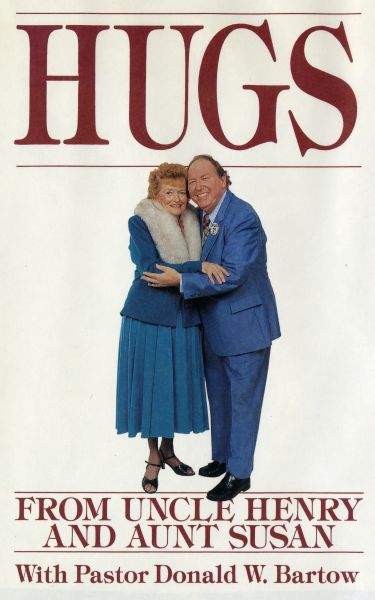 One of the unique ministries archived among the titles in the Evangelism and Mission Collection is chronicled in Hugs (1988) by Henry and Susan Harrison. Henry Harrison, D.D., served as co-host, (until replaced by Tammy Fay Bakker) and announcer for Jim Bakker’s PTL (“Praise the Lord”) Club, located at the Heritage, USA, campus, in Fort Mill, South Carolina. In addition to evangelism, “Uncle Henry” and his wife, “Aunt Susan,” as they were widely known, specialized in hugging. This excerpt from an interview reveals their passion:
One of the unique ministries archived among the titles in the Evangelism and Mission Collection is chronicled in Hugs (1988) by Henry and Susan Harrison. Henry Harrison, D.D., served as co-host, (until replaced by Tammy Fay Bakker) and announcer for Jim Bakker’s PTL (“Praise the Lord”) Club, located at the Heritage, USA, campus, in Fort Mill, South Carolina. In addition to evangelism, “Uncle Henry” and his wife, “Aunt Susan,” as they were widely known, specialized in hugging. This excerpt from an interview reveals their passion:
Interviewer: …To me, the most important feature is your license plate.
Uncle Henry: PTL/PHD. That’s PTL’s Pastor for the Hugging Department.
Interviewer: You had that specially made?
Uncle Henry: Yes, and I also designed one for Susan’s car. Her license plate is SUZ/HEN and when you pronounce it together it comes out “Susan.” But it’s for the two of us together, Susan and Henry.
Interview: That’s unique! Here’s a picture of the Upper Room at Heritage, USA. Are you there often?
Uncle Henry: Susan and I are there every weekday afternoon, Monday through Friday, for an hour of sharing and testimonies and hugging. And…I don’t think it is a sacrilege when I sometimes affectionately refer to it as “The Hugging Room.” I truly believe there is sweet communion in hugging on the part of believers.
Aunt Susan: When God said to Jim Bakker years ago, “Jim, if you’ll build me a place I’ll meet you there,” Jim took some of his people to Jerusalem and measured the Upper Room’s every inch and every column. The one at Heritage as as near a replica of that one as the local building code would permit. The Upper Room in Jerusalem has stone floors, but we do have a nice red carpet to kneel on. And we have the atmosphere — the spiritual atmosphere — that is so conducive to praise and worship and healing and salvation and all of the things people come there crying for in their spirits. They pray and intercede for their friends and family back home.
Hugs appeared one year before Jim Bakker’s devastating sexual scandal brought down the PTL empire. The Heritage property has since been portioned and sold to various developers. Quite poignantly, the Harrisons observe at the end of the book:
Aunt Susan: …I’d like to leave a parting thought on this. When a person is truly hurting to the very depths of their being — as in bereavement at the death of a precious loved one — the ear fails to register the meanings of the words being heard.
But the warmth and concern conveyed by a sincere, loving hug reaches and soothes the wounded spirit as nothing else can…Through this book our hugging people will continue long after we’re gone from this world.
Uncle Henry: I think of this book as being a kin to the Book of Acts in that it has no “amen,” but lives on in the lives of “hugging” believers! I don’t know who wrote these lines, but we’d like to leave them with you….Keep on huggin’!
Day of the Wolf
Coleman Luck, creator of “The Equalizer” and “Gabriel’s Fire,” pulls no punches in Day of the Wolf: Unmasking and Confronting Wolves in the Church (2015). Throughout the book, Luck offers personal anecdotes in the spiritual and psychological mechanics of dealing with wolves, whether in Hollywood or the church, or both in partnership.
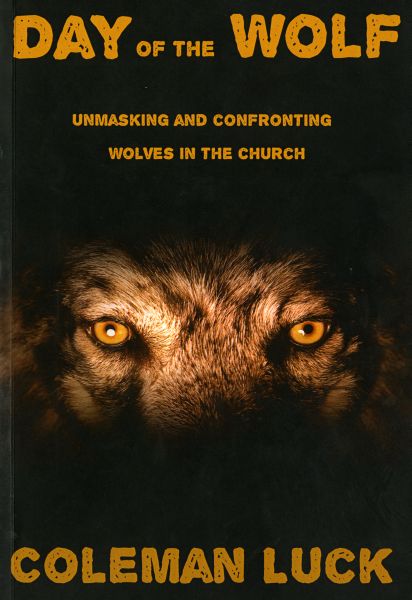 He writes, “This book has been written to call us all to account. For spiritual wolves, it is the most serious warning to repent while there is still time. Your soul is at stake. For those who follow and encourage wolves, it is a call to Biblical awareness, repentance and action. For those who have been wounded in wolf attacks, it is a call to forgiveness and healing. For everyone in the Christian Church it is a call to vigilance and, where needed, Biblical, Holy Spirit empowered confrontation, because things are going to get much worse.”
He writes, “This book has been written to call us all to account. For spiritual wolves, it is the most serious warning to repent while there is still time. Your soul is at stake. For those who follow and encourage wolves, it is a call to Biblical awareness, repentance and action. For those who have been wounded in wolf attacks, it is a call to forgiveness and healing. For everyone in the Christian Church it is a call to vigilance and, where needed, Biblical, Holy Spirit empowered confrontation, because things are going to get much worse.”
The Coleman Luck Collection includes the working materials of this contemporary novelist, television and screenwriter. His work on various network television series, as well as independent projects, are documented in this collection.
Learn more about Coleman Luck’s papers at Wheaton College.
More to Gain
 As professor and administrator, Dr. Bob Baptista, who died at 93 on Friday, October 9, demonstrated firm leadership and sound judgment on many levels during his years of service to Wheaton College. However, he most visibly exhibited his stellar character after coaching a 1966 soccer game, Wheaton vs. Lake Forest. The following article from the Chicago Sun-Times tells the story:
As professor and administrator, Dr. Bob Baptista, who died at 93 on Friday, October 9, demonstrated firm leadership and sound judgment on many levels during his years of service to Wheaton College. However, he most visibly exhibited his stellar character after coaching a 1966 soccer game, Wheaton vs. Lake Forest. The following article from the Chicago Sun-Times tells the story:
The winners made the protest as the aftermath of an unusual soccer game in which Wheaton College beat Lake Forest 1-0, it was learned Wednesday. Wheaton coach Bob Baptista didn’t learn from goalie Bill Bott until after the game two weeks ago that Lake Forest had also scored. The ball, kicked by a wing on a breakaway, went past Bob Bott’s arms and 50 yards beyond the goal. Play had resumed before the surprised goalie realized no official had recognized that the ball went through the net. Baptista and the officials found a torn cord near the bottom of the net through which the ball had zipped. Baptista offered to consider the game a tie if the contest had no bearing on the final standings of the league. He also offered to replay the game if it should become significant in the standings. “Suddenly and unexpectedly faced with the acid test,” Baptista told the student body, “Wheaton has a lot more to gain than to lose.”
Good Grief!
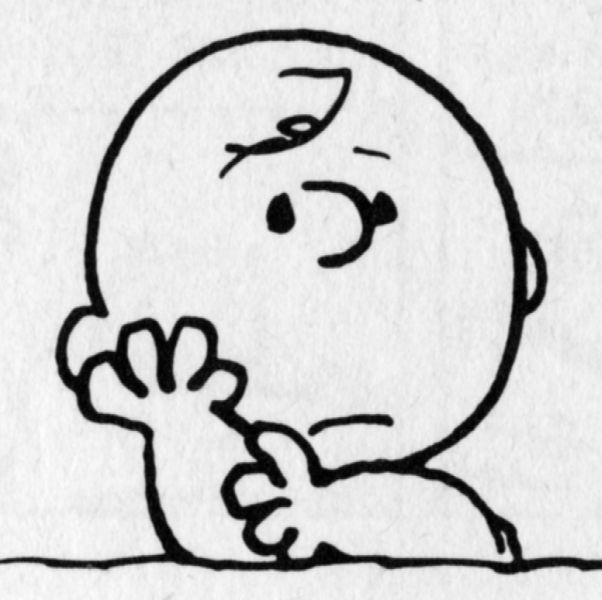 Charlie Brown, next to Mickey Mouse and Superman, is arguably the most iconic American comic strip character. Created by Charles Schulz, the Peanuts cartoon ran from October 2, 1950, to February 13, 2000. Amazingly, the final original strip appeared one day after the death of Schulz.
Charlie Brown, next to Mickey Mouse and Superman, is arguably the most iconic American comic strip character. Created by Charles Schulz, the Peanuts cartoon ran from October 2, 1950, to February 13, 2000. Amazingly, the final original strip appeared one day after the death of Schulz.
The April 24, 1958 Wheaton College Record features an odd article, without context, titled “Peanuts Comes to Campus.” Evidently an unnamed Wheaton College student traveled to Minneapolis to hear Schulz lecture about his popular syndicated strip. Schulz offers one or two interesting insights into his creative process.
Charlie Brown, Patty, Pig Pen, Lucy, Linus, Snoopy, Schroeder and Beethoven were at the University of Minnesota last month, brought by their creator Charles Schulz. Schultz drew as he talked. “Lucy says you can draw Charlie Brown’s head by using a pie plate,” Schulz said as he drew something that looked very much like it could be drawn with a pie plate, “but this is not necessarily so.”
He put a little sad face on the circle, drew a much-too-small body under it and introduced Charlie Brown. Then he covered the drawing with vertical streaks. “That’s rain,” he explained. Charlie Brown says, “It always rains on the unloved.”
“The strip,” says Schulz, “depicts high-toned sayings jammed down these little people.” He does all the work himself. “After all, there’s not much there — figures and graphs.” He drew Snoopy the dog in a frantic moment trying to find his way out of a patch of grass, “caught in the throes of weed claustrophobia.” Schulz has a hard time thinking up ideas for Pig Pen. “They’re planning Pig Pen doll, you know,” he told the Minnesotans. “When you set it down, a little cloud of dust rises.” He has trouble, too, with Schroeder, mainly because of the Beethoven bust on his piano. “I have a hard time drawing Beethoven. Sometimes he looks like James Mason and sometimes like Elsa Maxwell.”
Says the Tower, Schulz has some of the emotional problems as the Peanuts clan does. He is motivated by the belief that few people like cartoonists, and he “can’t stand” people who send in suggestions. His wonderment was matched on one occasion by that of little Linus. Clutching his “security blanket,” Linus listened intently to the story of Sambo and the tigers. When the story was over, Linus looked puzzled and asked the question one might expect any normal child to ask: “How in the world could anybody eat that many pancakes after undergoing such an emotional experience?”
Ogden Nash at Wheaton College
The Wheaton College Student Union usually invited quite “serious” public figures to lecture on campus, so it was surely a delight when they snagged Ogden Nash, the American poet of light humorous verse. 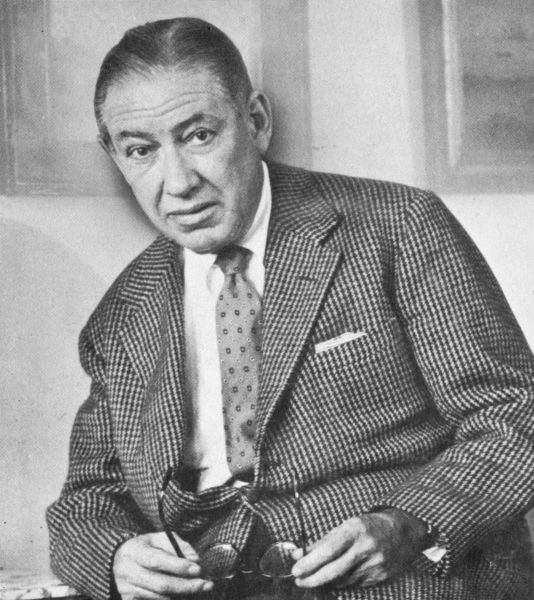 His poetry was famously featured in The New Yorker, The Saturday Evening Post and elsewhere. He spoke in Pierce Chapel at 8:30pm on April 30, 1958. Admission to the event was $1.
His poetry was famously featured in The New Yorker, The Saturday Evening Post and elsewhere. He spoke in Pierce Chapel at 8:30pm on April 30, 1958. Admission to the event was $1.
His books include Everyone But Thee and Me, Parents Keep Out, You Can’t Get There from Here and Custard the Dragon. Among Nash’s New York literary circle were E.B. White, Dorothy Parker and S.J. Perelman.
Campus reaction to Nash’s performance is not recorded, nor is the notoriously liberal poet’s response to his conservative Christian audience. Not noted for theological reflection, Ogden Nash did observe:
God in his wisdom made the fly,
And then forgot to tell us why.
Nash was an active member of St. Andrews-by-the-Sea in New Hampshire, where his bespectacled face was immortalized on a stained-glass window. He died in 1971. At his funeral this poem was read:
I didn’t go to church today,
I trust the Lord to understand.
The surf was swirling blue and white,
The children swirling on the sand.
He knows, He knows how brief my stay,
How brief this spell of summer weather,
He knows when I am said and done,
We’ll have plenty of time together.
Wes Craven at Wheaton College
Elm Street — where nightmares undoubtedly occur — is located six blocks south of Wheaton College, but Wes Craven never lived in the last house on the left or anywhere else on that shaded lane. In fact, residing near the campus as a student, he rented rooms in 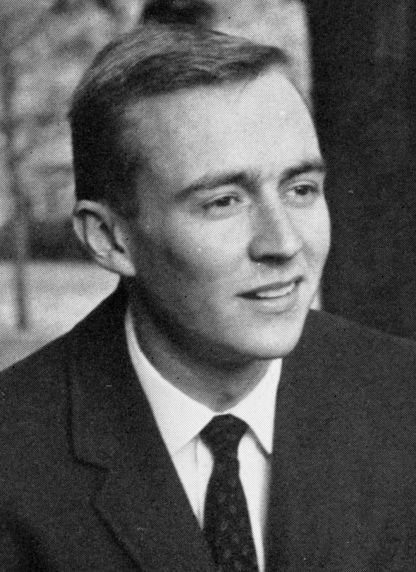 three different homes at various times on Scott, President and Franklin streets. The wildly successful film director, who died of brain cancer at 76 on August 30, 2015, studied English at Wheaton College from 1957-63. Raised in a strict Christian home in Cleveland, Ohio, his family was somewhat concerned that Wheaton College was “too liberal.” Inquisitive with a touch of the maverick, Craven was anxious to explore the power and passion of language, especially during the topsy-turvy 1960s. The March, 1962 Kodon, the Wheaton College literary magazine, sponsored a Creative Arts Festival with Pulitzer Prize-winning author Gwendolyn Brooks as one of the judges. Craven won first prize in the short story category. Serving as editor for the Fall, 1962 Kodon, he prophetically writes:
three different homes at various times on Scott, President and Franklin streets. The wildly successful film director, who died of brain cancer at 76 on August 30, 2015, studied English at Wheaton College from 1957-63. Raised in a strict Christian home in Cleveland, Ohio, his family was somewhat concerned that Wheaton College was “too liberal.” Inquisitive with a touch of the maverick, Craven was anxious to explore the power and passion of language, especially during the topsy-turvy 1960s. The March, 1962 Kodon, the Wheaton College literary magazine, sponsored a Creative Arts Festival with Pulitzer Prize-winning author Gwendolyn Brooks as one of the judges. Craven won first prize in the short story category. Serving as editor for the Fall, 1962 Kodon, he prophetically writes:
This edition of KODON will be controversial. It was not planned to be so, and were things ideal, it would not raise a whisper of protest. But the ideal is never here. So be it. Besides, a controversy is healthy, I feel, and constructive if carried on honestly and fairly. Let us hope that this will be the case in the consideration of this magazine’s contents….In addition, there is the conviction in this office that, in the arts, the Fundamental Christian world, and more specifically Wheaton, is sadly short of its potential and far behind its contemporaries. Therefore the copy of this magazine will remain (as long as the present staff remains), free and limited only by the criteria and the boundaries of artistry.
Braced for the fallout, Craven published two edgy-for-the-era stories, “A New Home,” by Marti Bihlmeier, about an unwed mother, and “The Other Side of the Wall” by Carolyn Burry, about an interracial couple. As predicted, the stories stirred discomfort in the campus community and were not well-received by the administration. Soon Dr. V. Raymond Edman, President of Wheaton College, informed Craven that he had failed in his duties as editor. Consequently, publication of Kodon was suspended for a year. Interestingly, this issue also features work by Jack Leax and Jeanne (Murray) Walker, who would enjoy successful careers as published poets and professors of literature.
As a senior Craven was stricken with Guillan-Barre syndrome, paralyzed for several months from the chest down, delaying his graduation by nearly a year. During this difficult time he was visited by friends and several strangers. “I remember feeling terribly down,” Craven told a reporter in a June 8, 1997 Chicago Tribune interview. “People I didn’t know came to visit, to pray for my recovery.  To me, their thoughts and prayers represented the best side of Christianity. I’ll never forget that side of Wheaton College. Never.” A retired professor remembers Wes Craven as “a fine, serious-minded student” who excelled in Shakespeare and drama. In addition to deep, wide reading, Craven played guitar in a folk band.
To me, their thoughts and prayers represented the best side of Christianity. I’ll never forget that side of Wheaton College. Never.” A retired professor remembers Wes Craven as “a fine, serious-minded student” who excelled in Shakespeare and drama. In addition to deep, wide reading, Craven played guitar in a folk band.
Leaving Wheaton, he completed his graduate degree in philosophy and writing at Johns Hopkins. He briefly taught school in New York before committing his prodigious talents to Hollywood. Specializing in horror franchises, his directorial debut was The Last House on the Left (1972). Craven went on to write or direct A Nightmare on Elm Street (1984), The Serpent and the Rainbow (1988), Scream (1996) and the non-scary drama Music of the Heart (1999), starring Meryl Streep, who garnered an Academy Award nomination for her performance. He also published a novel, The Fountain Society (1999) and co-scripted a graphic-novel series called Coming of Rage (2014).
A Question Answered
Aside from the institution of slavery, Jonathan Blanchard, founder of Wheaton College, loathed the Masonic Lodge. Speaking at various churches and civic events, Blanchard seldom lost an opportunity to discredit the Lodge and its secret rites. On one occasion, however, he might have uttered a few words too many. The following editorial was published in the Wheaton, Illinoisian on August 12, 1887:
Replying to a question asked by J. Blanchard in what he was pleased to call a sermon, Sunday evening, August 7, at the Baptist church, “What Lodge in the country gave a dollar to pay for scraping lint or preparing anything for the comfort of the soldiers?” I would answer that Wheaton Lodge No. 269, F. & A.M., then in its infancy, gave one hundred and fifty dollars ($150.00) for that purpose. The Lodge at Naperville, Il, a like amount, and the Lodges all over the country gave for the same purpose. Query: What did the head of the house of Blanchard give to aid in carrying on the war? On the contrary, I am credibly informed that this same Blanchard discouraged the enlisting of students, saying of them, “Let the scum of society go first.” W.H. Johnson, Wheaton, Ill, Aug. 10, 1887.
Thanks to Robert Shuster of the Billy Graham Center Archives for providing this article.
Her fault
 When God promises to heal the land, as he does in II Chronicles 7:14, he is predicting the return of the Jew to Israel the homeland, though contingent upon national repentance. When missionaries leave their home country for a foreign field, they often harbor hopes of “healing” the land, or preaching the gospel and serving needy peoples. But when Agnes Sanford, charismatic author and lecturer, moved from the East Coast to California in her later years, she had something far more literal in mind as she applied her extraordinary gifts. She writes in Creation Waits (1976):
When God promises to heal the land, as he does in II Chronicles 7:14, he is predicting the return of the Jew to Israel the homeland, though contingent upon national repentance. When missionaries leave their home country for a foreign field, they often harbor hopes of “healing” the land, or preaching the gospel and serving needy peoples. But when Agnes Sanford, charismatic author and lecturer, moved from the East Coast to California in her later years, she had something far more literal in mind as she applied her extraordinary gifts. She writes in Creation Waits (1976):
When I moved to California in order to be nearer to my children and also to be handy to the San Andreas Fault in order to pray for it, I looked for a house….When I pray for the San Andreas Fault, that is settle its differences, or make its adjustments to the earth that is even now being gradually pushed up from the ocean, I see with the eyes of faith God’s healing and constructive power, God’s life-force of light, shining into the mountains beneath which the fault lurks, and causing these areas of new land to develop so gently, so gradually, that there shall be no destructive earthquakes. Many people, encouraged by the newspapers, seem to gloat in the prospect of a destructive earthquake, and to delight in foretelling it. However, God is more powerful than all newspapers and gloomy prophets who foresee calamity.
The paper of Agnes Sanford (SC-174) are archived in the College Archives & Special Collections.

